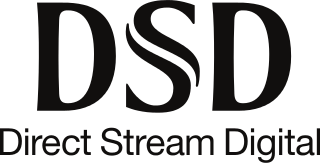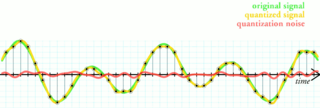
In electronics, an analog-to-digital converter is a system that converts an analog signal, such as a sound picked up by a microphone or light entering a digital camera, into a digital signal. An ADC may also provide an isolated measurement such as an electronic device that converts an analog input voltage or current to a digital number representing the magnitude of the voltage or current. Typically the digital output is a two's complement binary number that is proportional to the input, but there are other possibilities.
Dynamic range is the ratio between the largest and smallest values that a certain quantity can assume. It is often used in the context of signals, like sound and light. It is measured either as a ratio or as a base-10 (decibel) or base-2 logarithmic value of the difference between the smallest and largest signal values.

In signal processing, pre-emphasis is a technique to protect against anticipated noise. The idea is to boost the frequency range that is most susceptible to noise beforehand, so that after a noisy process more information can be recovered from that frequency range. Removal of the distortion caused by pre-emphasis is called de-emphasis, making the output accurately reproduce the original input.
Signal-to-noise ratio is a measure used in science and engineering that compares the level of a desired signal to the level of background noise. SNR is defined as the ratio of signal power to noise power, often expressed in decibels. A ratio higher than 1:1 indicates more signal than noise.

In electronics, a digital-to-analog converter is a system that converts a digital signal into an analog signal. An analog-to-digital converter (ADC) performs the reverse function.
Sound can be recorded and stored and played using either digital or analog techniques. Both techniques introduce errors and distortions in the sound, and these methods can be systematically compared. Musicians and listeners have argued over the superiority of digital versus analog sound recordings. Arguments for analog systems include the absence of fundamental error mechanisms which are present in digital audio systems, including aliasing and associated anti-aliasing filter implementation, jitter and quantization noise. Advocates of digital point to the high levels of performance possible with digital audio, including excellent linearity in the audible band and low levels of noise and distortion.

In signal processing, sampling is the reduction of a continuous-time signal to a discrete-time signal. A common example is the conversion of a sound wave to a sequence of "samples". A sample is a value of the signal at a point in time and/or space; this definition differs from the term's usage in statistics, which refers to a set of such values.

Audio system measurements are a means of quantifying system performance. These measurements are made for several purposes. Designers take measurements so that they can specify the performance of a piece of equipment. Maintenance engineers make them to ensure equipment is still working to specification, or to ensure that the cumulative defects of an audio path are within limits considered acceptable. Audio system measurements often accommodate psychoacoustic principles to measure the system in a way that relates to human hearing.

Direct Stream Digital (DSD) is a trademark used by Sony and Philips for their system for digitally encoding audio signals for the Super Audio CD (SACD).

Quantization, in mathematics and digital signal processing, is the process of mapping input values from a large set to output values in a (countable) smaller set, often with a finite number of elements. Rounding and truncation are typical examples of quantization processes. Quantization is involved to some degree in nearly all digital signal processing, as the process of representing a signal in digital form ordinarily involves rounding. Quantization also forms the core of essentially all lossy compression algorithms.
Dither is an intentionally applied form of noise used to randomize quantization error, preventing large-scale patterns such as color banding in images. Dither is routinely used in processing of both digital audio and video data, and is often one of the last stages of mastering audio to a CD.
In signal processing, oversampling is the process of sampling a signal at a sampling frequency significantly higher than the Nyquist rate. Theoretically, a bandwidth-limited signal can be perfectly reconstructed if sampled at the Nyquist rate or above it. The Nyquist rate is defined as twice the bandwidth of the signal. Oversampling is capable of improving resolution and signal-to-noise ratio, and can be helpful in avoiding aliasing and phase distortion by relaxing anti-aliasing filter performance requirements.

Delta-sigma modulation is an oversampling method for encoding signals into low bit depth digital signals at a very high sample-frequency as part of the process of delta-sigma analog-to-digital converters (ADCs) and digital-to-analog converters (DACs). Delta-sigma modulation achieves high quality by utilizing a negative feedback loop during quantization to the lower bit depth that continuously corrects quantization errors and moves quantization noise to higher frequencies well above the original signal's bandwidth. Subsequent low-pass filtering for demodulation easily removes this high frequency noise and time averages to achieve high accuracy in amplitude which can be ultimately encoded as pulse-code modulation (PCM).
A 1-bit DAC is used as a consumer electronics marketing term describing an oversampling digital-to-analog converter (DAC) that utilizes a digital noise shaping delta-sigma modulator operating at many multiples of the sampling frequency that outputs to an actual 1-bit DAC. The combination can have high signal-to-noise and hence an equivalent effective number of bits as a DAC with a larger number of bits.

In digital audio using pulse-code modulation (PCM), bit depth is the number of bits of information in each sample, and it directly corresponds to the resolution of each sample. Examples of bit depth include Compact Disc Digital Audio, which uses 16 bits per sample, and DVD-Audio and Blu-ray Disc, which can support up to 24 bits per sample.
Effective number of bits (ENOB) is a measure of the dynamic range of an analog-to-digital converter (ADC), digital-to-analog converter, or their associated circuitry. The resolution of an ADC is specified by the number of bits used to represent the analog value. Ideally, a 12-bit ADC will have an effective number of bits of almost 12. However, real signals have noise, and real circuits are imperfect and introduce additional noise and distortion. Those imperfections reduce the number of bits of accuracy in the ADC. The ENOB describes the effective resolution of the system in bits. An ADC may have a 12-bit resolution, but the effective number of bits, when used in a system, may be 9.5.
A Bitcrusher is an audio effect that produces distortion by reducing of the resolution or bandwidth of digital audio data. The resulting quantization noise may produce a "warmer" sound impression, or a harsh one, depending on the amount of reduction.

In signal processing, sub-band coding (SBC) is any form of transform coding that breaks a signal into a number of different frequency bands, typically by using a fast Fourier transform, and encodes each one independently. This decomposition is often the first step in data compression for audio and video signals.
Pulse-code modulation (PCM) is a method used to digitally represent sampled analog signals. It is the standard form of digital audio in computers, compact discs, digital telephony and other digital audio applications. In a PCM stream, the amplitude of the analog signal is sampled at uniform intervals, and each sample is quantized to the nearest value within a range of digital steps.
Pulse-density modulation, or PDM, is a form of modulation used to represent an analog signal with a binary signal. In a PDM signal, specific amplitude values are not encoded into codewords of pulses of different weight as they would be in pulse-code modulation (PCM); rather, the relative density of the pulses corresponds to the analog signal's amplitude. The output of a 1-bit DAC is the same as the PDM encoding of the signal.
















